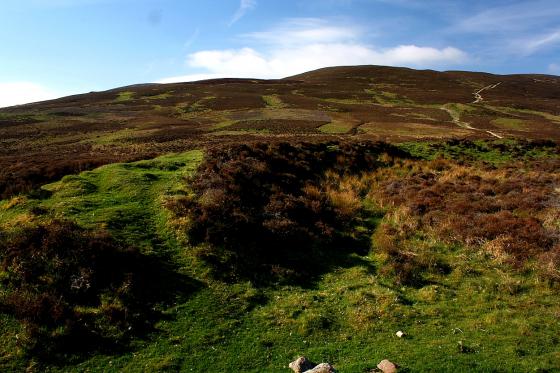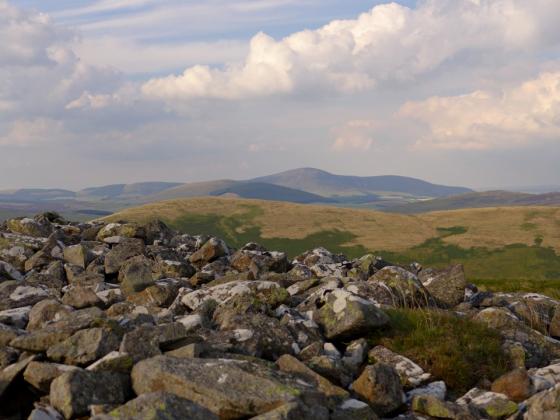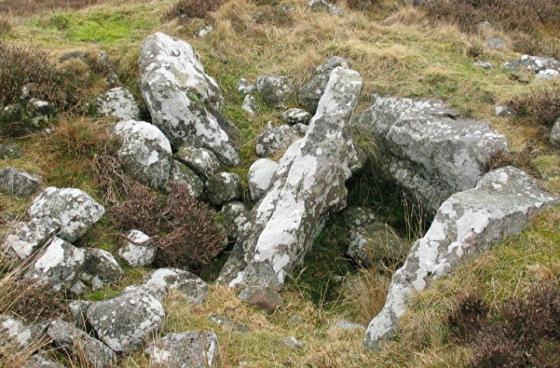





What was this all about, then?


Tinto rises beyond. Was this ‘enclosure’ a companion piece to Tinto’s great cairn in a ritual landscape?


A golden early morning upon a frankly puzzling, enigmatic site....

The double line of more-or-less contiguous stones that demarcate this hill top enclosure are surely too slight to have been defensive.... in fact too slight for pretty much any use I can think of back in the day. And why wasn’t the Fallburn hillfort placed here rather than down below? Guess one possible reason is Park Knowe was already ‘taken’... by a ritual enclosure of some nature that the Iron Age locals weren’t gonna mess with.
In my opinion the sentinel feature of the South Lanarkshire landscape is the great Bronze Age cairn surmounting the sprawling, elephantine bulk of Tinto. Now I’m assuming this is not an overly contentious assertion, the monument visible for miles around... well, at least when not subsumed within an all too frequent mantle of low cloud, that is. My choice of the most enigmatic site in the locality – Park Knowe – is, however, far more subjective... not least since, I guess, the very meaning of ‘enigmatic’ is itself equivocal and subjective.
Crowning a low, seemingly insignificant hill to the north-east of the aforementioned, dominating Tinto, a designation of ‘Enclosure’ upon the relevant OS map does little to promote a visit here. Why indeed, what with the fine Iron Age earthworks of Fallburn perfectly placed below (to the approx west) to detour any travellers still retaining a little residual energy not expended during the ascent to the massive cairn? In fact, arising from an overnight camp to a vividly bright dawn, it is only a chance reference to a ‘ring of standing stones at Park Knowe’ (or words to that effect) upon the Fallburn car park noticeboard that raises my curiosity. Whatever could it mean?
So... standing upon the ancient ramparts of Fallburn a short time later I find myself intrigued as to why this impressive hill fort was not itself erected upon Park Knowe, obviously a far more naturally defensible location... assuming the latter’s enclosure is indeed less structurally significant? Hey, suffice to say a visit is now not only required, but essential. However, upon arrival, close proximity nevertheless does little to resolve the conundrum. Yeah, the summit of the hill is indeed girdled by two, roughly concentric banks; however these are so diminutive in stature – a thin rubble core held in position by a line of contiguous stones on each face – as to suggest their function was to merely delineate the enclosure? For this was surely no hill fort, the pragmatic RCAHMS classification justified:
“In view of the slightness of the banks, the monument cannot be classed as a fort... in the 18th century the interior is reported (OSA 1791) to have contained “a large mound of earth”. There is no indication of this mound at the present time, and if it ever existed it was presumably levelled when ploughing encroached upon the site. (RCAHMS 1978)..”
So what do these remains upon Park Knowe represent? If the enclosure did, in fact, once feature a ‘large mound of earth’ I’d suggest it’s not unreasonable to hypothesise a low level companion to Tinto’s incomparable monument rising to the south-west, standing within an enclosure devoid of any defensive characteristics or intention. For me the fact that the Iron Age locals chose to build their great fortified home below Park Knowe – rather than take advantage of its clear defensive worth – is indicative that something of very significant (non-military) importance already occupied the summit, something that had to be left inviolate. Or suffer the consequences.
That this mysterious structure still exists, still accords wondrous views across the surrounding landscape this golden morning... still has the capacity to confound, to send thoughts cascading around this human brain in a futile quest for immediate comprehension... is truly something to behold in a age where ‘everything’ can seemingly be answered in an instant at the activation of an on line app. Ha! Not everything, or so it would appear!
I find it difficult to define, let alone relate, what characteristics a prehistoric site must possess to be considered ‘enigmatic’. However I have to say Park Knowe is probably as close to a physical representation of this nebulous term as I’ve yet encountered in these Isles.


















































